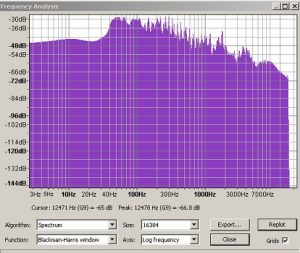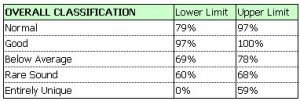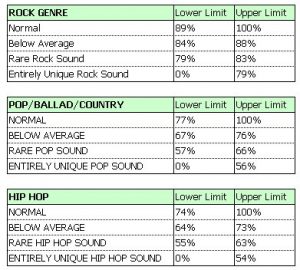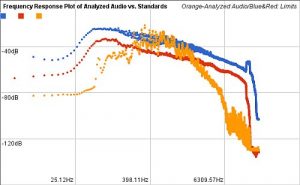**Note: 128kbps MP3 is used as the target file type since the computing algorithm uses this format for generating test specification. Finally click OK and then click “Save” the file to your Desktop or any folder you like.
7.) Then in Audacity, you need to open this converted MP3 file. Go to File –> Open; locate the rendered 128kbps MP3 file in the previous step. Then go to Analyze –> Plot Spectrum. Set it as follows:
Algorithm: Spectrum
Function: Blackman-Harris window
Size: 16384
Axis: Log Frequency
Click “Replot”.
8.) Click “Export” button. Assign a name of the raw data file, e.g. your_song_title.txt
Make sure it uses .txt file extension. Save it to your Desktop or any convenient location in your computer to access
9.) You have successfully generated your raw data. Exit Audacity. Don’t save any changes.
10.) Now click the “Upload Raw Data” button below to submit the text file (.txt) to the server and wait until the processing is complete.
Interpreting % Frequency Balance Rating Results
The higher the percent rating for your audio, the higher the similarity of your track frequency response to reference tracks. The algorithm consists of test specifications which are formulated based on reference tracks that consist of a lower limit and upper limit.
Anything that exceeds these limits is out of specification and lowers the rating of the track frequency balance. If the frequency balance rating is high, normal or OK, the majority of the points fit within the test specifications.
Frequency balance rating depends on the quality of the recording material, the mix and the genre of the track. Below is the rating guide for your guidance:
A.) Assessment by Overall Classification
Description: This is the general assessment of the track frequency balance regardless of a music genre.
B.) Assessment by Genre
Description: This is the specific assessment of the track frequency balance with respect to a music genre.
EXAMPLE: Supposing the frequency balance rating is 83%. By looking at the ratings’ guide table below; this means that:
a.) By overall classification (if you don’t mind the genre), it is considered having a normal or acceptable frequency balance.
b.) If the genre of the track is rock, it is considered “rare” and not having the frequency balance common to modern rock tracks.
c.) Otherwise if this belongs to pop/ballad and country genre, the frequency balance is considered OK.
d.) Same thing with the hip-hop genre, this response is considered OK.
To view the track audio frequency response vs. test specifications, I recommend that you download the offline version of this tool (read the next section). This is an example plot:
As a quick interpretation, the track substantially lacks bass and treble response; actually this track is recorded in a low-fidelity cassette voice recorder.
Improving the quality of audio track frequency response
First, it should be well-recorded (in digital at least 24-bit/44.1KHz). Then the audio mixing should be well crafted. Finally the frequency balance is done in audio mastering process.
The engineer will be working closely with high quality audio mix down file (usually 24-bit/44.1KHz format) and will be doing EQ adjustments to balance the response. If you are doing your own mastering, I highly recommend you will download the offline version of this tool here:
(Latest version: 1.2, October 9, 2012)
It provides additional benefits not found in this online version such as:
1.) Performing frequency band analysis (per bass, mid and high audio frequency sections) to troubleshoot problematic sections in the audio frequency response.
2.) Formulating EQ settings to correct frequency balance issues.
3.) Confirming improvements in frequency response after EQ adjustments.
The goal of your adjustment is to obtain reasonable % frequency balance rating that makes your mixes sound comparable to broadcast quality/commercially released tracks. I highly recommend you check out the related tutorials below for an example application of this tool in audio mastering.




